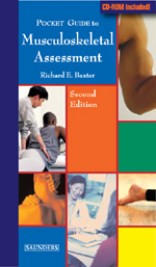|
|
|
| |
 |
|
|

|
 推薦指數:
推薦指數:





|
|
- 內容介紹
|
Pocket Guide To Musculoskeletal Assessment, 2nd Edition
Richard E. Baxter PT, DSC, OCS, ATC, Physical Therapist, United States Army
ISBN 0721697798 · Paperback · 240 Pages
Saunders · Forthcoming Title (July 2003)
The second edition of this handy reference tool includes even more special tests, treatment options and resources to help physical therapy students perform thorough and efficient musculoskeletal assessments of patients. Organized in outline format, each of the 15 chapters includes an overview of subjective and objective examination topics for a specific body region or system, followed by a quick reference table of special tests and treatment options. The expanded appendices also include a number of assessment tools and resources that will be useful to both students and professionals.
The guide's small size and lay-flat spiral binding make it easy for students to refer to during actual patient treatment if they need to check on a test for a particular body region. Graduated tabs marking the location of each chapter and appendix will make it easier for students and clinicians to find information quickly.
Features
Chapters are written in an outline format so readers can quickly find the information they need.
Examination outlines utilize the "subjective" and "objective" portions of the traditional SOAPG note format --making the guide accessible to any health professional who performs musculoskeletal assessment.
Special tests and treatment options are presented in tables, providing succinct, up-to-date information on the most common tests and treatment options.
The convenient pocket size and lay-flat, spiral binding provides increased portability and usefulness.
The extensive appendices of assessment tools and resources provide additional options for patient assessment.
What's New
The addition of many new special tests, including Scapular pinch, O'Brein's, Pain provocation, Anterior/Posterior load and shift, Biceps load, Posterior impingement sign, and Anterior slide tests (Chapter 3, Shoulder); TFCC load, Piano key, and Watson/radial stress tests (Chapter 5, Wrist & Hand); Hop and fulcrum te(Chapter 8, Hip); and Swain test (Chapter 9).
Updated treatment options, plus the inclusion of additional treatment options, such as a description of neuromuscular training exercises for shoulder conditions, new treatment for finger injuries, mobilization and manipulation treatment options for the thoracic and lumbar spine, Femoral shaft stress fracture and Osteitis pubis for the hip, and Perturbation training for ACL deficient knees
Expanded resources, including the Glasgow coma scale, information on blister care, the McGill Pain Questionnaire, Physical Therapy Preferred Practice Patterns, the UCLA Shoulder Scale, Modified Oswestry Low Back Pain Disability Questionnaire, and the 2000 IKDC Subjective Knee Evaluation Form.
Contents
Introduction
1. Cervical Spine
2. Shoulder
3. Elbow
4. Wrist and Hand
5. Thoracic Spine
6. Lumbar Spine
7. Hip
8. Knee
9. Foot and Ankle
10. Respiratory Evaluation
11. Inpatient Physical Therapy Cardiac Evaluation
12. Lower Extremity Amputee Evaluation
13. Neurologic Evaluation
14. Inpatient Orthopedic Evaluation
Appendixes
A. Dermatomes
B. Sclerotomes
C. Auscultation
D. Normal Range of Motion
E. Ligament Laxity Grading Scale
F. Capsular Pattern and Closed Back Positions for Selected Joints
G. Blister Care
H. Brachial Plexus Diagram
I. McGill Pain Questionnaire
J. Radiology
K. Physical Agent and Modalities
L. Types of Traction
M. Normal Values for Commonly Encountered Laboratory Results
N. Physical Therapy Preferred Practice Patterns
O. Abbreviations and Definitions
|
|
|

